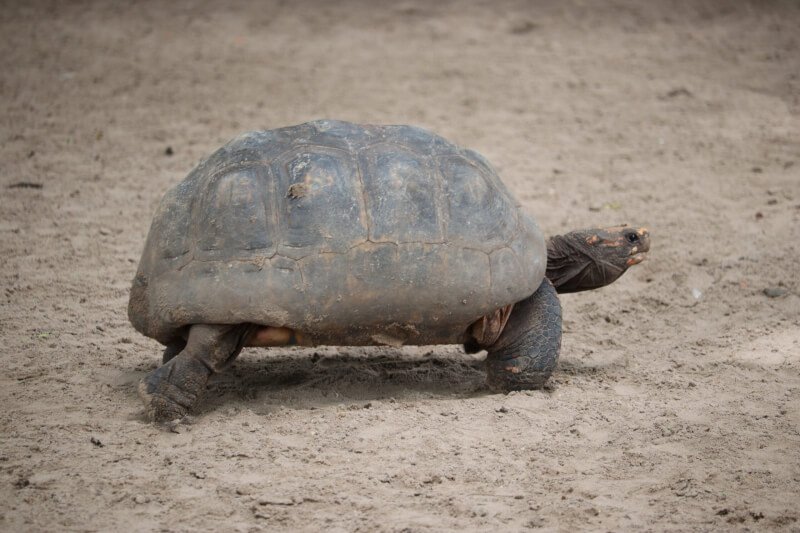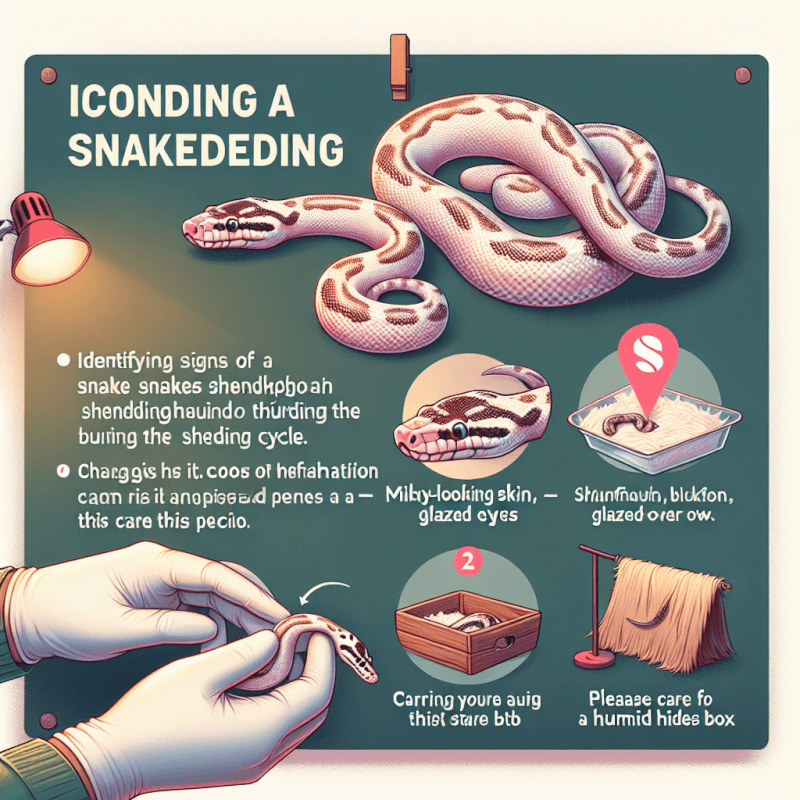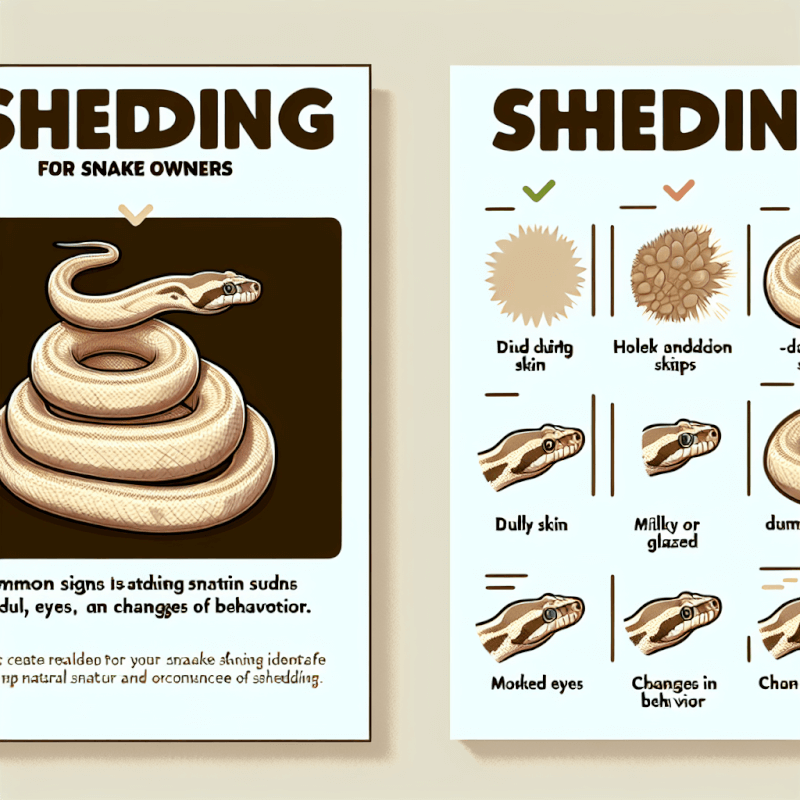If you’re a snake owner, you know how fascinating it is to witness your scaly friend go through the process of shedding its skin. But how can you tell if your snake is actually in shed? Well, there are a few telltale signs to look out for. Keep an eye on your snake’s eyes – if they appear cloudy or bluish, it’s a clear indication that it’s shedding. Additionally, you may notice your snake being more irritable or less active, as discomfort during shedding is not uncommon. Understanding these signs will help you better care for your slithery companion and ensure they have a smooth and successful shed.
Physical Signs
Cloudy eye
One of the most common physical signs that your snake is in shed is a cloudy eye. During the shedding process, a milky or opaque film may cover your snake’s eye, making it appear dull and cloudy. This cloudy eye is a result of the outer layer of the eye, known as the cornea, separating from the underlying layers in preparation for shedding.
Dull or faded color
Another physical sign to look out for is a dull or faded color in your snake’s scales. As your snake prepares to shed, its skin loses its vibrancy and may appear lackluster or faded. This is due to the buildup of the new skin underneath the old one, causing the colors to appear muted.
Milky scales
In addition to a dull color, you may notice that your snake’s scales have a milky or opaque appearance. This is a result of the new skin developing underneath the old skin. As the shedding process progresses, the old skin will become looser, allowing the new skin to emerge.
Blue or gray patches on skin
Another physical indication that your snake is in shed is the presence of blue or gray patches on its skin. These patches, often referred to as “pre-shed blues,” occur when blood vessels under the snake’s skin become more visible. This blueish hue is a temporary condition and will disappear once the shedding process is complete.
Loss of appetite
During the shedding process, your snake’s appetite may decrease or even disappear altogether. This is completely normal and can be attributed to the discomfort or stress associated with shedding. It’s important not to force-feed your snake during this time, as it may lead to regurgitation or other digestive issues.
Behavioral Changes
Increased restlessness
If you notice that your snake is more restless than usual, it could be a sign that it is in shed. Restlessness can manifest in various ways, such as increased activity, pacing back and forth in its enclosure, or constantly moving its head from side to side. These behaviors are attempts to slough off the old skin.
Reduced activity level
On the other hand, some snakes may become more lethargic and display a reduced activity level when they are preparing to shed. This is because shedding requires a significant amount of energy, and your snake may conserve its energy by staying still and minimizing its movements.
Hiding more often
Snakes that are in shed often seek out hiding spots more frequently than usual. This behavior is a natural response to the vulnerability they feel during the shedding process. By finding a secluded and safe spot, your snake is attempting to protect itself during this delicate time.
Rubbing against objects
Another behavioral change to watch out for is your snake rubbing its body against objects in its enclosure. This rubbing helps facilitate the shedding process by removing any loose or stubborn pieces of skin. Providing objects, such as branches or rocks, for your snake to rub against can help alleviate any discomfort.
Refusing to eat
It is not uncommon for snakes to refuse food when they are in shed. The loss of appetite is typically temporary and should not cause alarm. During this time, your snake’s focus is on shedding, and it may not have the same drive to eat. It’s important to monitor your snake’s weight during this period and consult a reptile specialist if there are any significant concerns.

Eye Cap Retention
Incomplete shedding of eye caps
Eye cap retention occurs when a snake is unable to shed the eye caps completely. These are the clear protective coverings that cover the snake’s eyes. If the eye caps are not shed properly, they can be left behind and cause potential issues such as blockage of vision or irritation.
Blindness or impaired vision
If your snake experiences eye cap retention, it may result in blindness or impaired vision. The leftover eye caps can obstruct the snake’s visibility, making it difficult to navigate its environment. This can lead to stress, disorientation, and an increased risk of injury.
Irritation and discharge around eyes
Another sign of eye cap retention is irritation and discharge around the eyes. The retained eye caps can cause discomfort and inflammation, leading to redness, swelling, or even infection. If you notice any signs of irritation or discharge, it’s crucial to seek veterinary assistance to address the issue promptly.
Preparing for Shedding
Ensure proper humidity levels
One of the most important steps in preparing for shedding is to ensure proper humidity levels in your snake’s enclosure. Maintaining an appropriate humidity range is essential for the shedding process, as it helps soften the old skin, making it easier for your snake to slough off. The ideal humidity level varies depending on the species of snake, so it’s important to research the specific requirements for your snake.
Provide a moist hide
A moist hide is a designated area within your snake’s enclosure that contains damp substrate or a humidifier to create a microclimate with higher humidity. This provides your snake with a controlled environment where it can retreat to during shedding. The increased humidity in the hide assists in loosening the old skin and promoting a successful shed.
Misting or soaking options
In addition to a moist hide, misting the enclosure with water or providing a shallow water dish for soaking can help increase humidity levels. This is especially beneficial for snakes that require higher humidity levels or those experiencing difficulties shedding. Misting the enclosure a few times a day or offering regular soaking sessions can offer the necessary moisture for a successful shed.
Avoid handling during shedding
During the shedding process, it’s essential to minimize handling your snake as much as possible. Handling can cause stress and disrupt the shedding cycle. The gentle rubbing and pressure exerted during handling may also interfere with the shedding process. It’s best to let your snake go through the shedding process undisturbed to ensure a smooth shed.

Assisting the Shedding Process
Check for stuck shed
Regularly check your snake for any signs of stuck shed. Pieces of old skin that remain attached to your snake, particularly around the eyes, tail, or in between scales, can lead to complications if not removed. Carefully inspect your snake’s body for any retained shed and gently remove it using damp cotton swabs or your fingers.
Provide a shedding aid
Some snakes may require additional assistance during shedding. Commercially available shedding aids, such as shedding sprays or solutions, can be used to help soften the old skin and facilitate shedding. These products are typically sprayed directly onto the snake’s skin and can aid in the removal of stubborn shed.
Consult a reptile veterinarian
If you are unsure about how to assist with the shedding process or if your snake is experiencing difficulties, it’s important to consult a reptile veterinarian. They can provide guidance and expert advice tailored to your specific snake’s needs. A veterinarian can also assess your snake’s overall health and address any underlying issues that may be contributing to poor shedding.
Potential Complications
Retained skin or shed
Failure to remove all the shed skin or eye caps can lead to retained skin, which can restrict blood flow and cause constriction. This can be particularly dangerous if it occurs around vital areas, such as the tail or toes. Regularly check your snake for any retained skin and take the necessary steps to remove it.
Infections or respiratory issues
Poor shedding or eye cap retention can increase the risk of infections or respiratory issues in snakes. The areas of retained shed or eye caps can provide a breeding ground for bacteria or fungi, leading to infections. Additionally, if your snake has difficulty shedding, it may be a sign of an underlying respiratory issue that should be addressed by a veterinarian.
Eye injuries or damage
Eye cap retention can cause injury or damage to your snake’s eyes if left untreated. The retained eye caps can press against the delicate tissues of the eye, leading to scratching, corneal ulcers, or even blindness. Timely intervention and careful removal of the eye caps can help prevent these complications.
Starvation or dehydration
Snakes that experience prolonged shedding difficulties may suffer from dehydration or malnutrition. The stress and energy expenditure associated with shedding, coupled with decreased appetite, can lead to weight loss and overall decreased health. Monitoring your snake’s weight and ensuring it has access to water throughout the shedding process is crucial in preventing these complications.

Helping with Difficult Sheds
Increase humidity levels
If your snake is experiencing difficulties shedding, increasing the humidity levels in its enclosure can help soften the old skin and promote a successful shed. Mist the enclosure more frequently or provide a larger water dish for soaking. The higher humidity will create a more favorable environment for shedding.
Warm soaks
Gentle warm soaks can provide relief and assistance during difficult sheds. Fill a shallow container with warm water, making sure it is not too hot, and allow your snake to soak for 10-15 minutes. The warm water helps loosen the old skin, making it easier to remove. Be sure to supervise your snake during the soak and provide a way for it to exit the water if desired.
Gentle handling and rubbing
In some cases, gentle handling and rubbing can help dislodge stubborn shed. Using dampened hands or a damp cloth, gently stroke your snake’s body in the direction of shedding to encourage the removal of old skin. Take care not to apply too much pressure or cause any discomfort to your snake.
Use shedding aids and lubricants
If your snake is struggling with shedding, consider using commercially available shedding aids or lubricants. These products can help soften the old skin, making it easier for your snake to shed. Follow the instructions provided with the product and apply it directly to your snake’s skin, focusing on areas of concern.
Recognizing a Successful Shed
Clear eyes
After shedding, your snake’s eyes should appear clear and free of any cloudiness or retained eye caps. The eyes should be bright and alert, indicating a successful shed.
Vibrant coloration
A successful shed often reveals vibrant and glossy scales with a restored coloration. The new skin should appear fresh and healthy, with the colors appearing more vivid compared to the muted tones of the old shed.
Intact and complete shed
A successful shed should result in a complete removal of the old skin, including the eye caps. Your snake should be free of any retained shed and should not have any pieces of skin still attached to its body.
Restored appetite and activity
Following a successful shed, your snake’s appetite and activity levels should return to normal. It should show an interest in food and resume exploring its enclosure. These signs indicate that your snake is healthy and thriving.

Monitoring Shedding Frequency
Frequency varies by age and species
The shedding frequency of snakes varies depending on their age and species. Young snakes generally shed more frequently than adult snakes, as they are growing at a faster rate. Additionally, different snake species may have different shedding patterns. It’s important to research and understand the shedding requirements specific to your snake’s age and species.
Keep a shedding log
Keeping a shedding log can help you monitor and track your snake’s shedding frequency. Note down the dates of each shed, as well as any observations regarding its condition and any difficulties encountered during shedding. This log will provide valuable information to help identify any potential issues or irregularities in your snake’s shedding cycle.
Consult a reptile specialist
If you have concerns about your snake’s shedding frequency or notice any abnormalities, it’s always a good idea to consult a reptile specialist or veterinarian. They can provide expert advice, evaluate your snake’s overall health, and address any specific concerns or questions you may have.
Conclusion
Understanding the physical signs and behavioral changes associated with shedding is crucial for the well-being of your snake. By recognizing these indicators, you can provide the necessary care and assistance to ensure a successful shed. Regular monitoring of your snake’s shedding frequency, as well as maintaining proper humidity levels and seeking veterinary assistance when needed, will contribute to the overall health and happiness of your reptilian friend.



